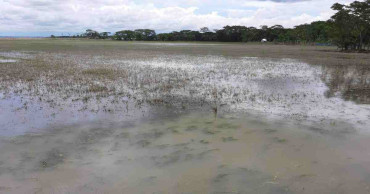salinity
No let-up in safe drinking water scarcity in Khulna’s Dacop
Over 2 lakh residents of salinity-hit Khulna’s Dacop upazila have been grappling with a severe shortage of safe drinking water since the onset of the dry season.
Long queues have become a common sight at shops selling purified open water, while some people are resorting to collecting water from distant sources.
The dire situation has forced some residents to consume water from ditches and drains, leading to an outbreak of various waterborne diseases, including diarrhoea.
Also Read: Many embankments turn vulnerable in Khulna’s Koyra; Fear grips residents
Dakop, which borders the Sundarbans, consists of three separate islands. Due to the high salinity levels in the surrounding rivers, the region experiences an extreme scarcity of fresh water during the dry season, said locals.
This year, as in previous years, the municipality and nine unions are grappling with an acute shortage of safe drinking water.
Visiting different areas in the upazila, the UNB correspondent found the scarcity of clean water has even affected the functioning of tea shops, restaurants, and sweet shops, frustrating shopkeepers who are unable to provide clean water to their customers.
Also Read: Walking the extra mile for water in coastal Khulna
The agricultural sector has also been severely affected , particularly in the current ‘Robi’ season when Boro paddy and watermelon farmers experiencing substantial losses due to the inability to irrigate their fields.
Most of the shallow tube wells have been lying inoperative and many tubewells contain salt, arsenic, and excessive iron content, exacerbating the water quality issues, said locals.
Furthermore, the region experiences insufficient rainfall, further limiting water availability.
Read more: Short Films on Water: Dhaka DocLab, British Council to screen four climate documentaries
Consequently, filtering water from ponds has become the only viable option for the locals. However, the scarcity of water in the inadequate ponds renders most filters or pond sand filters (PSFs) ineffective.
Wealthy individuals in the Batiaghata area of Khulna are able to purchase water from different locations, while middle-class and low-income residents are left with no choice but to consume water directly from the pond.
Consequently, the scarcity of clean drinking water has compelled this large population to rely on unhealthy food and water, resulting in a surge of waterborne diseases, including diarrhoea.
Read more: Coca-Cola Foundation, WaterAid working to enhance water security in Bangladesh
Nimai Mandal, a UP member from Ward No. 9 in the Kalabagi area, along with many others, explained that they have to endure great difficulties in collecting fresh water from the neighboring Kailashganj area, a journey of approximately 4 to 5 kilometers by boat.
Meanwhile, those who have the means and resources, purchase water from outside the region.
Nimai Mandal highlighted that some vulnerable individuals in the area resort to directly consuming impure water from the pond.
Samaresh Mandal, a hotelier in Chalan Bazar, expressed his predicament, saying, “Due to the water shortage, I am unable to provide water to customers. As the water from the pond is unhealthy for consumption, we are forced to use it for washing plates."
Read more: Water crisis hits Boro cultivation in Feni ‘s Sonagazi
Similar concerns were echoed by Milan Mallick, a tea shop owner.
In response to the crisis, Mehdi Hasan Bulbul, Panel Mayor of the Chalan Municipality, said that a water purification plant has been completed in the municipality under a water project aimed at resolving the drinking water crisis.
Additionally, house-to-house pipeline works are underway in various areas of the municipality.
Bulbul thinks that once these projects are completed, the shortage of fresh water in the municipality area will be significantly alleviated.
Abdullah Al Mahmud, Sub-Assistant Public Health Engineer of Dakop Upazila, said there are ongoing projects.
Read more: Dhaka calls for enhanced int'l financing for sustainable water management
However, he also said that these efforts are inadequate against the region's requirements.
To meet the growing demand for water, the engineer suggested individually and institutionally digging ponds and ‘dighis’ during the critical period.
Expanding the number of rainwater harvesting tanks and ponds in the region is deemed essential to mitigate the water crisis, he added.
Munsur Ali Khan, Chairman of Dakop Upazila Parishad, said the Upazila Parishad has initiated a project to distribute water tanks among underprivileged families.
Measures are being taken to excavate ponds and canals as alternative water sources, he said.
Read more: How to Build Dhaka as a Water Wise City
2 years ago
Sundarbans Day: Biodiversity under threat as salinity increases
'Sundarbans Day' will be observed on Monday as every year since 2002 with an appeal to save the largest mangrove forest in the world.
Virtual discussions have been organized in Bagerhat, Khulna, Pirojpur, Satkhira and Barguna due to covid situations like last year.
Rafiqul Islam Khokon, executive director of a private development agency 'Rupantor', said the day will be observed with the slogan 'Love the Sundarbans on the World Valentine's Day'.
This time alternative employment for the people dependent on the Sundarbans will be focused on in this event. There is human pressure on forests for livelihood. Local people adjacent to the forest should be involved in different activities to protect the forest, said Chief Forest Conservator Md Amir Hossain Chowdhury.
Also read: Tiger recovered from Sundarbans canal most likely died of natural causes
Sundarbans, a World Heritage site, hosts a complex network of tidal waterways. The forest presents an excellent example of ongoing ecological processes and many of its flora and fauna are unique to this region.
However, salinity in the Sundarbans is increasing due to climate change. Besides, the flow of water in the rivers and canals of the forest is decreasing gradually and several canals of the forest have been filled with silt.
Sundari trees are dying due to excessive salinity. Wildlife is also being affected by various diseases by consuming salt water. In the Sundarbans, wild animals are being hunted and people do fishing by spraying pesticides in rivers and canals which threaten the biodiversity of the Sundarbans.
According to various sources, there are 450 small and big rivers-canals in the Sundarbans. Due to lack of water flow, several small and big canal beds in the Sundarbans have been filled with silt. A variety of wild animals, including tigers and deer, leave the Sundarbans, cross canals, and enter the locality very often and lose their lives.
Muhammad Belayet Hossain, divisional forest officer (DFO) of the Sundarbans East Division, said over 20 canals in the area under the Sundarbans East Division have been filled with silt. Besides, a 30 km area of Bhola river from Jaymoni to Das Bharani, Kharma canal and Aruarber canal has been filled.
In this situation, various demands have been raised at different times to protect the Sundarbans, including celebrating 'Sundarbans Day' nationally. There is also a demand for the formation of a separate ministry for the Sundarbans.
Also read: Govt withdraws ban on tourist launch movement in Sundarbans
Executive Director of Sundarbans Academy Anwarul Qadir said that they have been demanding the formation of a separate ministry for the management of the Sundarbans to conserve the Sundarbans and improve the living standards of the people living near the forest. He is hopeful that if their demands are met, the fortunes of the forest and its people will improve.
Rafiqul Islam Khokon, executive director of 'Rupantor', said the first National Sundarbans Conference in Khulna ended on 14 February 2001 with the 'Sundarbans Declaration'.
Some 80 organizations including Rupantar, Khulna University, Bangladesh Poribesh Andolon (BAPA) jointly organized that conference.
At the conference, it was decided to observe 'Sundarbans Day' on February 14, and asked the government to observe 'Sundarbans Day' nationally.
Since 2002, Sundarbans Academy, Sundarbans Division, various press clubs and various organizations have been observing 'Sundarbans Day' on 14th February in the districts adjoining the Sundarbans.
In the eighteenth century, the area of the Sundarbans was almost double that of today. In 1878, the Sundarbans was declared a protected forest. The Unesco Commission of the United Nations declared three Sundarbans sanctuaries as World Heritage Sites in 1997.
In 2017, the government expanded the sanctuary area in the Sundarbans. Out of the total forest area of 6,01,700 hectares, now the sanctuary area is 3,17,900 hectares. Earlier it was only 1,39,700 hectares.
It has 375 species of wild animals, the Royal Bengal Tiger and other threatened species such as the estuarine crocodile, the Indian python, and the gangetic dolphins.
3 years ago
Sunflower cultivation in Khulna: Salinity no longer a barrier
Salinization of soil is a serious problem in the coastal areas of Bangladesh as it has adverse effects on crop production. Despite the challenge, farmers in Khulna’s coastal areas have shown success in cultivating sunflower in fallow saline land.
New possibilities have been created to meet the demand for high-quality sunflower oil. Farmers are also expecting bumper yields at low cost.
Research is underway on sunflower cultivation in the Robi season in the Salinity Management and Research Center of Batiaghata Upazila of Khulna under the Gopalganj-Khulna-Bagerhat-Satkhira-Pirojpur Agriculture Development Project (SRDI Organ).
Read Gaibandha women turn problem into profit
Sunflower seeds have been sown in wet soil here by the ‘dibbling method’ after harvesting Aman paddy in mid-November. Then the roots of the seedlings were tied and fertilizer was applied.
Three varieties have been used in the study- Local, Bari Suryamukhi-2, and Haisan-33. Of these, the yield of Haisan-33 variety has been good.
According to the chief scientific officer of the Center for Salinity Management and Research, sunflower is the salinity-tolerant crop. As a result, there is huge potential for sunflower cultivation in coastal areas.
Also read: Khulna farmers strike gold with sunflower
Vast tracts of land remain unused in the south, after harvesting Aman paddy. It is difficult to grow any other crop easily as there is salinity in the soil and water. By cultivating sunflower through the dibbling method, the fallow land will come under cultivation.
4 years ago
Sharankhola paddy farmers struggling with rise in salinity post-Amphan
The farmers of Sharankhola upazila of Bagerhat district have become frustrated with the increased salinity affecting their crop lands since Cyclone Amphan ripped through the country on May 20, leaving a vast tract of land unfit for cultivation.
5 years ago

.jpg)




